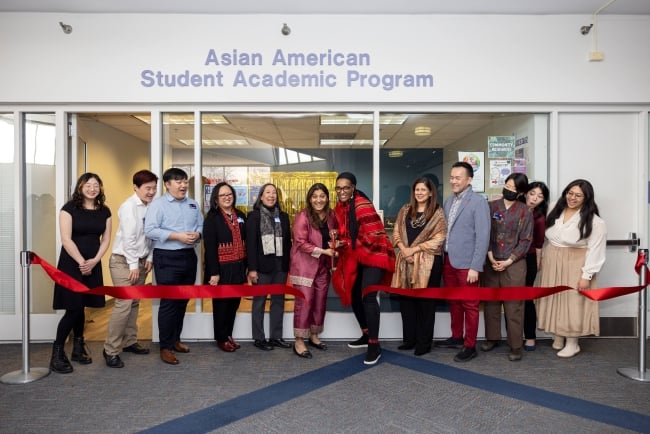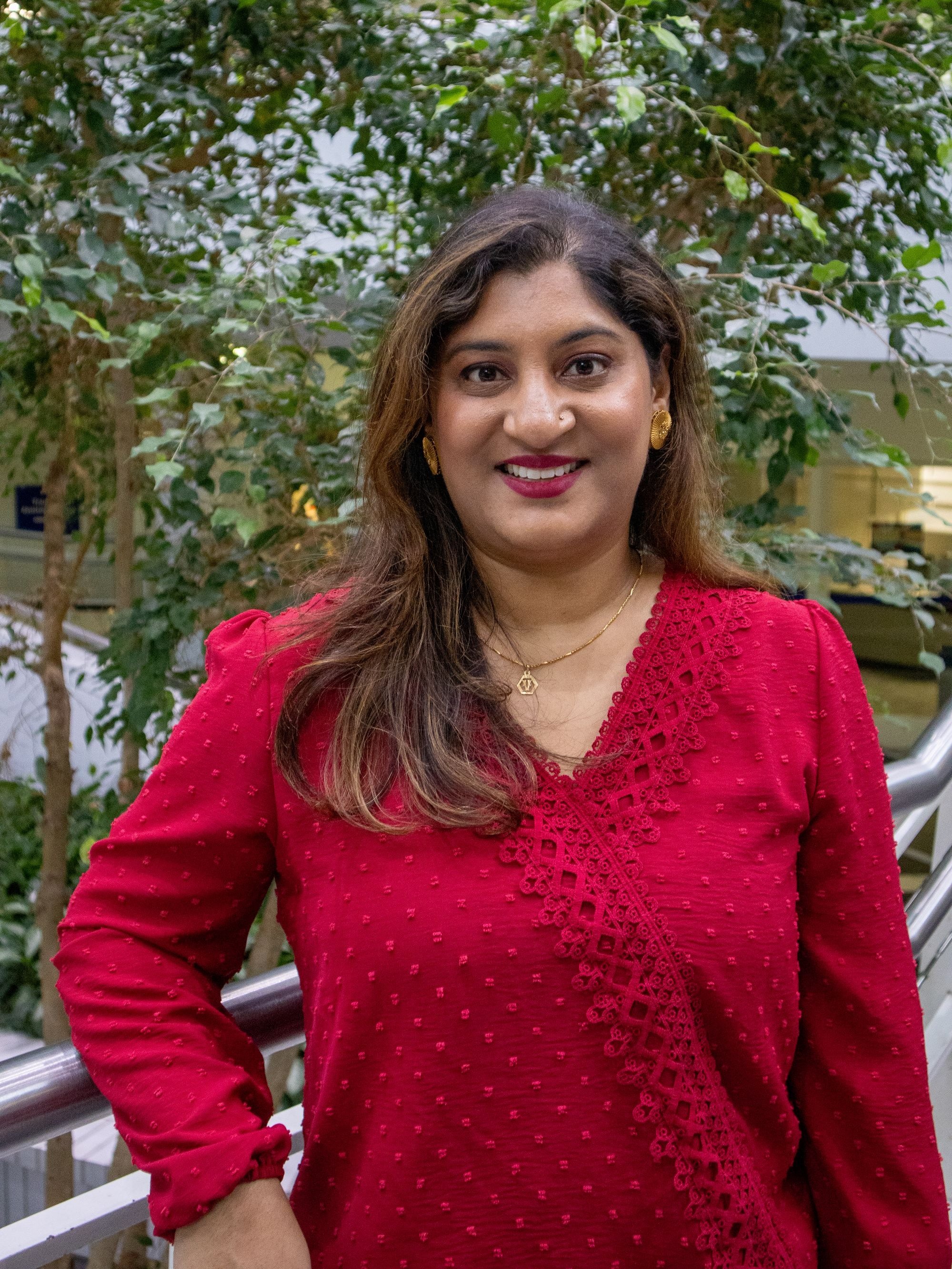You have /5 articles left.
Sign up for a free account or log in.

The Asian American Student Academic Program office at the University of Illinois at Chicago officially opened in April, offering a physical place for Asian American students to seek support for their academics and life skills.
UIC
As an undergraduate student, Viraj Patel found her community with the Asian American Cultural Center at her alma mater.

Viraj Patel, director of the Asian American Student Academic Program at the University of Illinois at Chicago
Viraj Patel, UIC
“I found mentorship, co-curricular enrichment, I could really nurture that intellectual curiosity and learn about history that I’d never learned about before,” Patel says.
Now, as the inaugural director of the Asian American Student Academic Program, Patel and her team are providing culturally competent resources, support and guidance for the University of Illinois at Chicago’s Asian American population and education for the campus at large.
UIC is an Hispanic-Serving Institution (HSI) and an Asian American and Native American Pacific Islander–Serving Institution (AANAPISI) and 21 percent of the university’s undergraduates are Asian.
Inside Higher Ed spoke with Patel about her work, the need for additional supports for Asian American students and her short- and long-term goals for the office.
Q: How does your role contribute to the institutional vision for student success?
A: I started as the inaugural director for the Asian American Student Academic Program here at the University of Illinois, Chicago, in January 2023. Between when I finished undergrad—also in Illinois, although at a different campus—and now, I actually spent about 10 years on the East Coast. So it was really a privilege to come home in a lot of different ways to serve my community.
UIC is a minority-serving institution; it has status as both an HSI and an AANAPISI. The unit is funded jointly by the AANAPISI grant, and UIC with an MOU [memo of understanding] in place to transition full support to the university whenever the grant runs out.
The center was formed after about 30 years of student advocacy. So it didn’t come out of nowhere. There was a real sincere fight for this unit, by faculty, staff and alumni, for decades. And so, while really overdue, to be honest, to develop this unit, I’m really ecstatic to step into this legacy of advocacy, and I feel the care of so many people around when we do the work every day.
The Asian American Student Academic Program provides culturally relevant academic support initiatives, such as academic advising, retention coordination. We do some recruitment initiatives as well as partnering with schools strategically, and we collaborate with other units across campus.
Our institution has an explicit mission to serve the city of Chicago and so we’re really intentional about partnerships within the city. The core of our work, I’d say, is building one-on-one partnerships with students to serve their individual academic goals and tailor to their individual needs. But we also do some programming throughout the year focused on career development, financial management and wellness, again, through that lens of what’s culturally relevant and speaks to Asian American history and needs.
Q: What does that programming look like?
A: For career development, I actually went kind of classic with this, to do an etiquette dinner. But we framed it more about navigating cultural norms in a dinner interview setting, even though a lot of places don’t do interview dinners anymore, we just use that framework.
But really, it’s about: How do you navigate a formal situation that might be multigenerational? I think a lot of those sorts of programs tend to focus on rules, like, which fork do you use and all that kind of stuff, we actually created more of a space that was culturally affirming and asset-based around, “How do you advocate for yourself and your needs?”
A lot of folks in our community have dietary restrictions that aren’t met with traditional restaurants that folks go to. So we talked about how to politely advocate for yourself respectfully, how to also navigate conversations that might feel uncomfortable, how to set boundaries in that context.
Then we also talked like, “OK, here’s the forks used, but also, just remember that everyone probably was there at some point. And so it’s OK to not know some of these things, too.” We wanted to add cultural capital, but also remove the pressure to know it all.
Another program we did on career development, it was called “Spot Their Red Flags” workshop. We went through job descriptions that [staff] found over listservs that we’re on and we talked with students about how to read a job description and figure out what might not be the right fit for you? Or how to ask questions about that in the process.
Again, to advocate, recognize the different rules, informal and formal, around search processes, but also like how to read between the lines if you don’t have someone to coach you in that process. So those are two career programs we did.
Financial management, we did one program that was about how to navigate boundary setting with finances around the holidays. How do you talk to your friends about budgets or secret Santas and things like that? So again, working on communication and boundary-setting, which a lot of folks in our community have shared that they don’t feel comfortable with.
We also did one on culturally relevant meal prep. Thinking through how there’s a couple of Asian grocery stores near campus, we taught students how to maybe DIY a ramen bowl that’s nutritious and lower in sodium. So that was fun and a way for them to also see, “Hey, I don’t need to buy all this premade.”
We do a lot of one-on-one for financial management. We also do a lot of one-on-one advising on scholarship applications and empowering students on how to tell their story in ways that feel authentic to them.
Q: How does the office fit within the institutional organization?
A: The unit that we’re in and that we were created in is housed within the broader Office of Student Success and Belonging, which was also created a couple years ago. The Office of Student Success and Belonging has 12 offices that are focused on identity-conscious student success initiatives. And what I really appreciate about that, from an institutional perspective, is that the institution understands that students have different needs, and that it’s important to recognize affinity and finding a good fit in that process.
We really believe in offering many ways for students to find that fit and connection and recognizing that it all doesn’t need to rest in one space. And so even if the Asian American Student Academic Program is not the best fit for an Asian American student, there are other units that we can connect you to as well, that are also focused on student success, but just maybe through a different lens that’s going to feel good for them.
Q: What are some of the challenges for Asian American student success at UIC?
A: Our students are really stretched for time and resources. Forty-six percent of our students are first-gen, 54 percent are Pell Grant recipients, 80 percent are commuters, and we have a large number of transfer and nontraditional students.
So they’re spending hours each day working to support their families, attending class, in traffic, building co-curricular student experiences and, obviously, doing homework.
We’re really trying to center accessibility and reduction of bureaucracy in all of our work and programmatic initiatives to not add to the stress that they feel when they do need to work with us.
From an Asian American perspective, we’re feeling the impact of the model minority myth from both within and outside the community, it’s a real thing.
We’re investing in education about the concerns of Asian American students, and the histories of inequity impacting our Asian American students. We’re also recognizing that students may struggle with asking for help based on how this is internalized, or even framing.
One of the things I’ve talked about is framing our services as help versus partnership and support and focusing on goals in an affirming setting.
We’re thinking a lot about the ways that we communicate about our resources, how we can empower campus partners to also refer the resources and doing that culturally relevant work in student success.
I would say another major issue that we’re running into is the lack of disaggregated data that’s available. So both institutionally and nationally in research, we don’t have it, and it presents a lot of challenges.
When we get data that’s lump data, like, “This is what Asian students are feeling,” it’s honestly not always really helpful. We know that while there’s power in numbers and in organizing, we really do need that nuanced data in order to help support and connect with the students who would benefit the most from our services, and who might just be falling through the cracks, as we’ve seen for decades.
With more accurate data, we could develop targeted interventions, and right now that data just doesn’t exist. Part of our long-term strategic goals is advocating for more accurate data collection so that we can figure out what the problems are and solve them.
Q: How are students involved in the center?
A: Our capacity to do a large breadth of student engagement has been limited. We didn’t have all our staff hired until January of this year. And so it was really just like me at a table for the first six months. And what I was prioritizing more was one-on-one student connection.
I think that there’s a really fine line between having a space that’s student-centered and student-led. I don’t want to add burden to students to plan and program things. So I want to nurture their interests but I don’t want them to feel that when they come to the center, labor is going to be expected of them.
We start with just like a one-on-one conversation. We nurture their leadership and if they decide that they want to do something more, we are here to help them. But we don’t yet have a structure that’s sort of like students doing all the programming and things—and that’s intentional. We have developed some individual internship opportunities for students if they say they come in and they’re looking for that kind of experience. We’ve developed a few tailored internships for students to build public speaking skills, programmatic knowledge, peer mentorship, support and things like that.
Q: What are some short- and long-term goals you’re looking at?
A: FY25 is our first full academic year, where we are staffed—God willing—and in our physical location. So I’m really just going to go through a full advising cycle as a team where we can build connections at the start of the year and over the summer and continue to nurture them through the year.
We’re thinking about prioritizing and building understanding of our students’ needs-building systems, so that we can operationalize some of these things. And students can look forward to receiving communication from us at certain times of the year. We want to build in some trust and normalcy. So, really, structure building.
We also want to think about, and honestly just engage in the privilege of having a fully blank slate to start on. My supervisor and all of the stakeholders at the institution have just been amazing about developing a vision and letting me run with it with the team. I haven’t felt the burden of expectations in this process.
I want to leave space this year to also dream and implement new things and not just do things because that’s the way it’s been done, but rather making sure that we as a unit are developing the skill set to look at what data exists, figure out what the best approach might be to solve the problem based on existing research and lived experience. Not just recreating the models that we already know about. I’m ready to roll this year.
Do you have colleagues who should be reading our Student Success newsletter? Send them this link so they can subscribe (it’s free).








